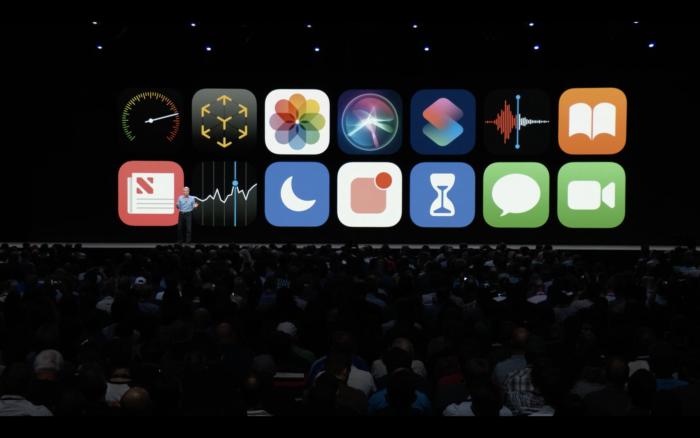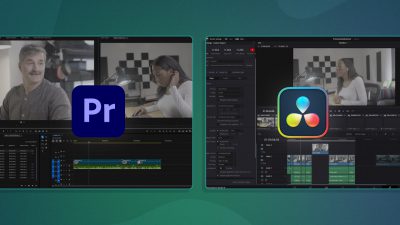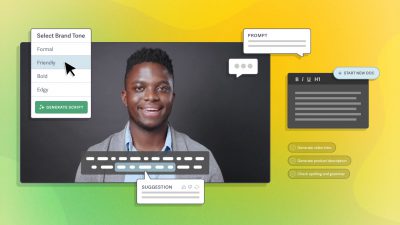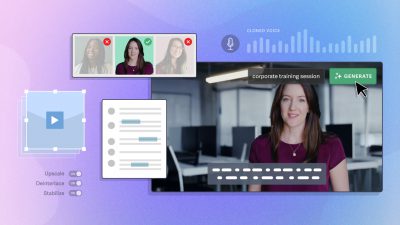Photo Credit: g-stockstudio on Shutterstock
Video is everywhere, and your next business conference should be no exception. After all, it’s one of the best ways to showcase the work of your company and employees, and can help engage attendees. However, video can be a distraction, or even feel intrusive if it’s not incorporated with intention.
So, how can you strike the right balance? Keep reading to find out how you can leverage video content at your next business conference.
1. Visual design and effects
A large part of a successful event is making it look appealing to attendees. It should feel like a cool, exciting place to be.
Video can help you visually set the stage for the innovations you’re planning to reveal. Use projections to create dramatic effects, or display decorative video screens on stage.
Think of Apple product announcements – the whole stage appears to be one massive screen.

Photo Credit: Macworld
With video, the drama and excitement imparted to viewers are correlated with screen size. So, don’t be afraid to go for a big effect!
2. Learning tools and accessibility
For some attendees, it might not be possible to see or hear presenters on stage. By using strategically placed screens, you can run a video feed of the main event to bring the action closer to the crowd.
These additional screens don’t necessarily need to project sound. Just providing a visual aid can be a huge help to some attendees.
If a live video feed isn’t possible, you can create recap viewing areas. Set up some comfortable seating, a few nice screens, and a quiet, focused environment.
There, participants can select presentations they missed or want to review. If possible, transcribe your sessions so audio isn’t required for comprehension, and provide wireless headphones.
3. Video recording booths for attendees
Everyone likes to feel special, and as though their opinion really counts. That’s why video booths, where attendees can film their reactions and takeaways, are becoming a mainstay at events.
There are advantages to setting up a booth compared to having people with cameras roam around the event. For starters, you can control the camera angle, lighting, and audio much more precisely. Also, people might feel more comfortable sharing their opinions in a more private area.
You don’t have to splurge on a service, either. Any quiet area with a back drop, decent lighting, and space for a tripod will do.
Of course, you have to make sure people use it. Here are ideas to get you started:
- Encourage attendees to get on camera by setting it up in a prominent space where people are congregating.
- Create enough space so people can bring a friend if they’d like.
- Make sure you craft questions and prompts in advance in case your on-camera talent freezes up.
- Use a special hashtag for sharing online so people can easily follow along.
- Offer prizes or swag to those who participate.
Post event, sift through the footage to find the best takeaways worth sharing. You can weave them into other footage from the event, or make a special highlight reel.
4. To showcase your products and their real-world applications
The strongest product presentations need proof – ideally something tangible to support what the speaker is saying. This can be done through video footage of the product, demonstrating the features and accessibility.
Microsoft does this particularly well, using promotional video and live demonstrations during conferences to showcase the unique capabilities that their software provides. At the Microsoft Build conference in early May, they debuted how real-time AI, Cortana and Microsoft 365 could be used in conjunction with one another in order to revolutionize meetings and collaboration on projects.
Simply recounting the features and the uses of the various software would have been impressive enough, but the live conceptual scenario showcased each individual feature. This is not only beneficial for the audience present, but translates well to video footage for those who could not make the event.
For instance, it is more engaging as a viewer to watch how the automatic transcript software works, and more impressive to directly experience the effect it has on the meeting, particularly in terms of accessibility. The demonstration showcases the positive impact it has on deaf employee Katie. Thanks to Microsoft’s technology, she was able to be fully involved in the meeting and bring her skills to the table without having to take notes.
Playing videos of your software or other products in action during a conference can give you the upper hand in engaging with an audience. It also allows you to show off the capabilities of all the best features.
5. To introduce your speakers
Conferences can feel impersonal and content-heavy. Videos can aid in making the atmosphere friendlier.
A sleek and well-produced video allows for a visually entertaining and more informative introduction to each speaker. It allows you to delve deeper into their background and experience than might be possible with a brief, spoken introduction.
A more interesting introduction will help set the tone for the rest of the talk. It also encourages the audience to connect with the content and participate in the event. Higher engagement leads to a more well-rounded and enjoyable experience for everyone involved. As an added bonus, it can also confer a positive association with the brand, product or service you are providing.
6. To include those who can’t be there
For attendees
Creating videos of the conference itself allows people who cannot physically attend the event to still participate. People from all over the world might be interested in the conference. However, some might not have the means to attend, or space at the physical event could be limited.
By releasing videos post-event, you can expand the reach of your conference. Use these videos to sustain interest, build thought leadership for presenters, and generate excitement in upcoming events.
Again, Microsoft and other big-name companies release conference videos after the event that can be viewed and referenced by those interested. This is a technique used by many companies for press releases. Similarly, organizations such as TEDx maintain an archive of their TED talks for those who cannot make the events, or are only interested in a specific topic or speaker.
For speakers
Sometimes, a highly sought-after speaker for your event might be physically unable to attend due to location, scheduling, or any number of other reasons. In these situations, a video of their talk can be invaluable. It can help ensure attendees are not disappointed, and potentially increase the interest in the event itself.
Having the talk pre-recorded makes things very simple. It is simply a matter of setting up the tech and hitting play.
However, a presentation that includes both video and a live speaker has the potential to be much more engaging and interesting. Video works well in presentations when it is used to examine two sides of the same coin, or explain aspects of a product in more depth.
7. To let others tell your story
By placing screens around your conference space, you can feature testimonial videos in favor of using your services and products. Use them to create an interactive exhibition of customer stories and case studies. Of course, these videos will also showcase various product features and their real-world applications.
Provide headphones or quieter listening spaces, or design the videos to be viewed without sound. That way, participants won’t be bombarded with noise, but can still interact with your content if they’d like.
Having multiple testimonial screens also means that the attendees are constantly engaging with the company even when no speakers are giving presentations, and allows for more stories to be told.
8. Recap, highlights, and thank you’s
Especially for larger events, it can be worthwhile to have a film crew on-hand during the conference. Your company can curate a highlight reel and recap of the day to share after the event. Encourage attendees, speakers and sponsors to view, and share on social media.
While you’ll want to share shorter clips immediately, you can leverage longer videos in different types of campaigns. For instance, you might want to incorporate some sessions into employee training programs. Or, use them to establish thought leadership, or subject matter expertise.
Your speakers are crucial to your event, so be sure to thank them with the best gift of all, video. Share well-edited video footage of each speaker’s talk with them for their own purposes. They’ll probably want to share it on their own websites and with their own audiences, in turn helping to promote your company or event.
Showing is always more powerful than telling. Leverage video to optimize the impact and lasting impressions of your next business conference or launch.
Find a style that suits your company, and create a smart and beautiful day that attendees, speakers and sponsors will remember. You may find that video content is the key to boosting the success of your event!








